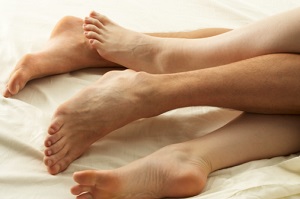Human sexuality is perhaps one of the most complex issues in the world. What is normal or not normal is often a matter of perspective and taste and one man’s fantasy is often another man’s nightmare. Despite these differences, people today tend to discuss and consider sexual topics with a “whatever floats your boat” approach. While this works fine for discussing sexual preferences, conversations about sexual disorders are something very different. For the most part, people think of impotence, premature ejaculation and other performance issues when they think of sexual disorders but those conditions can seem like a walk in the park when compared to some of the entries on our list.
Koror aka Genital Retraction Syndrome
Topping our list is Koro, a condition where a person believes their sex organs are retreating into their body. With men, the condition focuses on the belief that their penis is slowly but surely shrinking or, in some cases, being fully retracted into the body. This belief holds strong even when men measure their penis daily and find no long term shrinkage. The condition is extremely rare and is predominantly found in China, Japan and India. Men with the condition often believe they could be losing their penis thanks to supernatural intervention or as the result of cultural, ethical or sexual impropriety. While there’s no physical evidence to this condition, the hold it has on its victims is very real. Psychological treatments coupled with some traditional remedies are often used to treat the condition.
Anorgasmia aka Coughlan’s Syndrome
Delayed orgasm can be frustrating but is fairly common for both men and women from time to time. When a person cannot achieve orgasm over a long period of time and in spite of adequate stimulation and sexual therapy, the condition is called Anorgasmia or Coughlan’s Syndrome. Although the condition only happens sporadically in most people, there are those with Primary Anorgasmia, meaning they have never experienced an orgasm in their lives. This manifestation of the condition is found primarily in women while men are more likely to experience sporadic bouts.
Hypersexuality
 Hypersexuality is more commonly referred to as nymphomania and, in most cases, is discussed with a snicker and an elbow to the ribs. In reality, the condition is debilitating not only for the person suffering with it, but also for his or her family and friends. The condition is known as satyriasis in men and vulmania in women, but whatever the gender, the effects can ruin a life. In one case, a woman in the United Kingdom found she had a raging case of Hypersexuality after she suffered a major stroke. Over time, she had sex with more than 50 people and was unable to confirm whether or not she used protection. Her husband, while supportive at first, found his patience waning when he was repeatedly called home when his wife would try to have sex with strangers passing by the house or tradesmen who had come to check the gas meter or make scheduled repairs.
Hypersexuality is more commonly referred to as nymphomania and, in most cases, is discussed with a snicker and an elbow to the ribs. In reality, the condition is debilitating not only for the person suffering with it, but also for his or her family and friends. The condition is known as satyriasis in men and vulmania in women, but whatever the gender, the effects can ruin a life. In one case, a woman in the United Kingdom found she had a raging case of Hypersexuality after she suffered a major stroke. Over time, she had sex with more than 50 people and was unable to confirm whether or not she used protection. Her husband, while supportive at first, found his patience waning when he was repeatedly called home when his wife would try to have sex with strangers passing by the house or tradesmen who had come to check the gas meter or make scheduled repairs.
Priapism
Most men wouldn’t be rushing for treatment if they had an erection that lasted for hours. But if the condition kept happening, it wouldn’t be long before they were seeking help. Priapism is a condition where an erect penis does not return to its flaccid state after ejaculation for at least 4 hours. While 4 hours is the usual benchmark for diagnosis or treatment, the condition can last much longer and can cause intense pain. In extreme cases, the blood kept in the penis becomes starved for oxygen and can actually cause damage to the tissues.
Micropenis
Plenty of men worry about the size of their penis, but men with micropenis envy those guys. Micropenis is a rare but serious condition which results in men having an erect penis length of less than two inches. Although the penis functions normally, the condition can wreak havoc on a man’s personal life. Plagued by self-doubt and body issues, many men with this condition never become fully comfortable enough to maintain a serious relationship or even to simply have sex. This condition is incredibly rare and is thought to affect about 0.6% of the male population.










